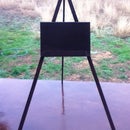Introduction: My Great Grandpa's Toolbox
Every summer we would go over to my Great Grandpa's house out on his ranch and see what cool things he had. Unfortunetly he passed away in August of 2010. He had all these awesome compasses, hammers and all sorts of old tools that were fun to look at. We would really all just take a second and think, " Holy cow, tools have changed so much from 1890's to now". Actually just last week my cruddy cardboard toolbox (not really a toolbox) fell apart and I thought about building another one and, ta da, I was inspired to build an old-fashion toolbox in dedication to my Great Grandpa.
Warning: Tools are dangerous and don't forget to wear safety equipment.
Step 1: Get Your Design Together
I'm pretty sure you can't build this without a design first so this step is the most important of all. You may need more height, width or length than me but you can follow my design if you'd like. This includes an optional set in tray that fits on a notch on the inside of the toolbox. Here is my design. Oh, and here are the measurements:
Base:
Length = 30 in
Width = 11 1/4 in
Long Side:
Length = 30 in
Width = 8 in
Short Side:
Tallest height = 15 in
Smaller height = 11 1/4 in
Width = 11 1/4 in
Set in tray:
Length = 29 7/8''
Width = 9 3/8''
Height = 2 1/2''
Step 2: Materials
Materials
1 2"x12"x16' Southern Yellow Pine (treated)
1 1"x12"x6' Knotty Alder
(I didn't have the 1''x12'' so I used my bisciut jointer to make 2 boards equal the width I needed)
1 1 1/8"x32'' Stainless steel dowel
A box of 2 1/4'' Stainless steel screws
Wood glue
Wood stain
Clear coat
Crown staples
Tools
Skill saw
Miter saw
Table saw
Crown stapler
Screw gun
1'' butterfly bit
1 3/8 drill bit
Optinal
Sander
Router
Surface planer
Biscuit jointer
Good attitude
Step 3: Cut and Plane Wood
Cut your material to the design lengths and prepare for assembly. The option of using your surface planer here will result in a more accurate finished product later.
Step 4: Notch for Tray
Cut a notch with a table saw (by adjusting the height of the blade) on the long sides of the toolbox like the pic. below and then the one after that. The first cut is 2 1/2'' deep. The second is 1/4''.
Step 5: Glue and Screw Pieces Together
Apply wood glue to the parts of the wood where it is necessary then screw them together.
Step 6: Cutting and Inserting Handle
In this step you need your stainless steel dowel. You will be inserting it through a hole on both sides of the toolbox. Pics. below will show you how.
Step 7: Routing the Edges
I love the end result of a router. Routing the ends of the toolbox made it great. I suggest that you should too.
Step 8: End Caps
End caps have to go on the end of the tool box where the excess pipe is to make it look good.
You can make these out of scrap Knotty Alder if you have some or just out of any other board. The dimensions of this are up to you.
Step 9: The Set in Tray
I love this part of the project. The tray looks so good when it's inside of the toolbox. The measurements for your tray depend on what size you made your toolbox. This includesthe handle that was made from Knotty Alder. Again, you may follow my design.
Note: The length of the short sides of the tray will determine the width of your base.
Note: The board with the handle cut into it is placed of center becaude of the fact that there is not enough space to put your hand in and pull the tray out.
Step 10: Sanding, Staining, and Clear Coating
.This the last step for assembly. Sand the parts where you want it to be sanded. Stain and polyurathane the entire toolbox, wait 2 hours and then it's complete.
Step 11: Load Your Tools Up
You're done. Now load your tools up in your old-fashion toolbox.
Attachments
Finalist in the
Woodworking Contest
Finalist in the
Gorilla Glue Make It Stick Contest














